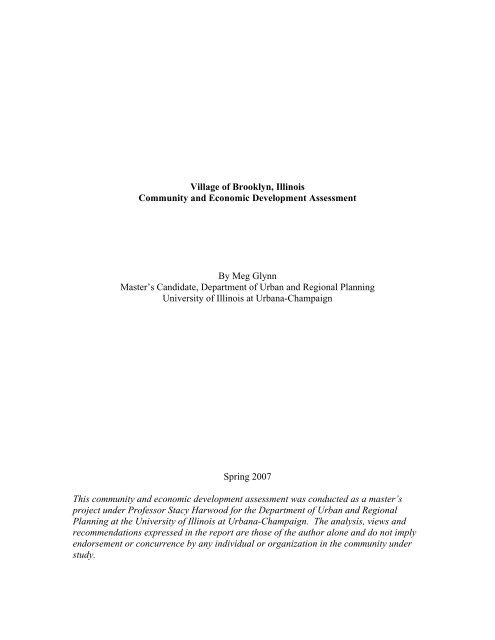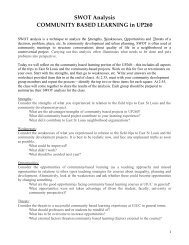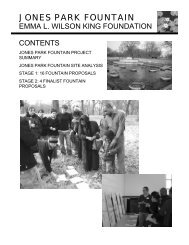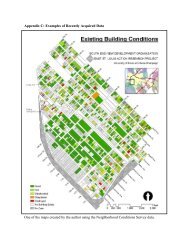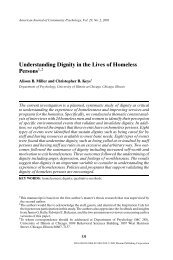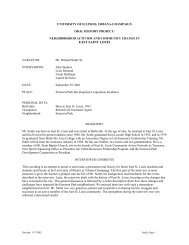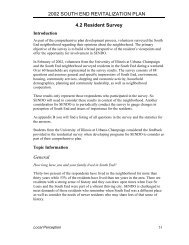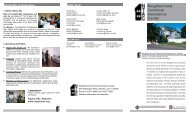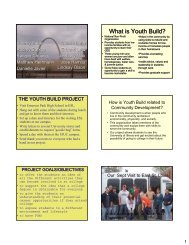Cover Page - East St. Louis Action Research Project - University of ...
Cover Page - East St. Louis Action Research Project - University of ...
Cover Page - East St. Louis Action Research Project - University of ...
Create successful ePaper yourself
Turn your PDF publications into a flip-book with our unique Google optimized e-Paper software.
Village <strong>of</strong> Brooklyn, IllinoisCommunity and Economic Development AssessmentBy Meg GlynnMaster’s Candidate, Department <strong>of</strong> Urban and Regional Planning<strong>University</strong> <strong>of</strong> Illinois at Urbana-ChampaignSpring 2007This community and economic development assessment was conducted as a master’sproject under Pr<strong>of</strong>essor <strong>St</strong>acy Harwood for the Department <strong>of</strong> Urban and RegionalPlanning at the <strong>University</strong> <strong>of</strong> Illinois at Urbana-Champaign. The analysis, views andrecommendations expressed in the report are those <strong>of</strong> the author alone and do not implyendorsement or concurrence by any individual or organization in the community understudy.
Village <strong>of</strong> Brooklyn, IllinoisCommunity and Economic Development AssessmentBy Meg GlynnTable <strong>of</strong> ContentsAcknowledgements................................................................................................... 4Executive Summary.................................................................................................. 5Introduction............................................................................................................... 6I. Institutional Memory: the History <strong>of</strong> the <strong>Project</strong>........................................... 9Introduction to Brooklyn.................................................................................. 9The <strong>University</strong>’s First Involvement with Brooklyn......................................... 10The <strong>University</strong>’s Re-Introduction to Brooklyn................................................ 11SWIDA............................................................................................................. 11The New Mississippi River Bridge.................................................................. 12Grant Endeavors............................................................................................... 13Riverfront Property Emphasis.......................................................................... 13II. Economic Development <strong>St</strong>rategies................................................................... 15The Brooklyn Business Center Economic Development Plan......................... 15Implementation <strong>of</strong> the Adopted Plan............................................................... 15Economic Development Plan or Modern-Day Urban Renewal....................... 16Previous Comprehensive Plans........................................................................ 16The New Mississippi River Bridge May Not Happen..................................... 16III. The Role <strong>of</strong> the <strong>University</strong>............................................................................... 18Community Participation Absent..................................................................... 18Communication................................................................................................ 18Linkage: Between CBOs & the Brooklyn Revitalization Committee.............. 19<strong>St</strong>arting Small: Establishing Working Relationships....................................... 19Summer Jazz Festival....................................................................................... 19Lovejoy Alumni Association Reunion/Family Reunions................................ 20Spring Bling..................................................................................................... 20Janey B. Goode Site......................................................................................... 20Underground Railroad History/Legacies <strong>of</strong> Hope/Confluence Trails.............. 21Signage for Historic Sites................................................................................. 22Brooklyn Cemetery.......................................................................................... 22<strong>St</strong>ites Park District............................................................................................ 23Placing Brooklyn into a Larger Context: Regional Planning........................... 23Identifying Community Values........................................................................ 23Creating a Community Land Trust................................................................... 23Further <strong>Research</strong>: Boundaries, Riverfront, Case <strong>St</strong>udies................................. 24Spring 2007<strong>Page</strong> 2 <strong>of</strong> 27
Village <strong>of</strong> Brooklyn, IllinoisCommunity and Economic Development AssessmentBy Meg GlynnTable <strong>of</strong> Contents (Continued)IV. AppendicesA: Land and ParcelsBrooklyn, Illinois: Location MapSanborn Fire Insurance Maps: 1905, 1955<strong>St</strong>. Clair County Maps: Boundaries, Parcels and Boundaries, ParcelsPlat Maps: <strong>St</strong>ites TownshipNew Mississippi River Bridge <strong>Project</strong>: Affected PropertiesVillage <strong>of</strong> Brooklyn: Government, Industry, Private OwnershipParcel Information: Number, Address, Owner Address, Class/ZoningLegal Proceedings: Sungo Inc. PropertiesLegal Proceedings: Platinum Club, RELMSS Service, Inc., VCG, Holdings, Inc.B: Brownfield InformationBrownfield Assessment Pilots: Southwestern Illinois Development AuthorityRCGA Roadmap: Turning Illinois Brownfields into Good DealsThe Role <strong>of</strong> the U.S. Army Corps <strong>of</strong> Engineers in Brownfield RedevelopmentC: Information Provided at Brooklyn Revitalization Committee MeetingsBrooklyn Demolition: Timeline, Parcel NumbersMichael Jones Foundation: Newspaper Article, February 2006RHCDA: Housing Development Analysis & RecommendationsProperties Owned by Railroad Companies in <strong>St</strong>ites TownshipRelocated Illinois 3: Presentation for SWIDA, July 2006, IDOTD: Planning Assistance to Illinois: Village <strong>of</strong> Brooklyn<strong>Project</strong> Manager, U.S. Army Corps <strong>of</strong> EngineersVillage <strong>of</strong> Brooklyn, Illinois Waterfront Master Plan: Existing ConditionsPlan Formulation: Brooklyn Business CenterPlan ImplementationE: Potential Community & Economic Development <strong>Project</strong>sBrooklyn’s Proud Past: Newspaper Article, 2007; Every Tone a TestimonyArchaeology: Newspaper Article, 2006; Illinois Antiquity Magazine, 2003Underground Railroad: Historic Context, <strong>Research</strong>ing & InterpretingMary Meachum Freedom Crossing: Schematic Design, FundingCity <strong>of</strong> <strong>East</strong> <strong>St</strong>. <strong>Louis</strong>: Riverfront InitiativeLEAM: Introduction to Legacy Plans and the <strong>St</strong>ate <strong>of</strong> Illinois Local Legacy ActSouthwestern Illinois Resource Plan, 2005Spring 2007<strong>Page</strong> 3 <strong>of</strong> 27
Village <strong>of</strong> Brooklyn, IllinoisCommunity and Economic Development AssessmentBy Meg GlynnAcknowledgementsI would like to acknowledge Pr<strong>of</strong>essor <strong>St</strong>acy Harwood <strong>of</strong> the Department <strong>of</strong> Urban andRegional Planning at the <strong>University</strong> <strong>of</strong> Illinois at Urbana-Champaign, seniorundergraduate planning student Senait Brown, and <strong>East</strong> <strong>St</strong>. <strong>Louis</strong> <strong>Action</strong> <strong>Research</strong><strong>Project</strong> (ESLARP) community liaison Billie Turner for their assistance with this project.Pr<strong>of</strong>essor Harwood encouraged participation in the project and initially attendedBrooklyn Revitalization Committee meetings as well as meetings with the BrooklynMayor. Pr<strong>of</strong>essor Harwood also provided useful research and development tactics t<strong>of</strong>urther the project. Senait was an invaluable partner for this project, following up withcontacts and asking questions at meetings. This project would have been infinitely moredifficult (and the three hour drive to Brooklyn incredibly boring) without her help andenthusiasm. ESLARP community liaison Billie Turner was also crucial to this projectbecause without her vast knowledge <strong>of</strong> <strong>East</strong> <strong>St</strong>. <strong>Louis</strong> and impressive number <strong>of</strong> personalcontacts in the area, we never would have spoken with Brooklyn residents. It alwaysseems that Billie knows the next person with whom you would like to speak regardingyour project or that she just happens to be neighbors with the woman speaking with thatperson!Additionally, I would like to thank Vicki Eddings, Janni Sorenson, and Bruce Wicks <strong>of</strong>the ESLARP staff. It was very helpful being able to talk through my project ideas withthem and discuss the latest Brooklyn redevelopment revelations. Thanks especially toVicki for accompanying Senait and I to the Brooklyn City Council meeting and to Brucefor providing information about the <strong>St</strong>ites Township Park District.Lastly, I would like to acknowledge the assistance <strong>of</strong> DURP master’s candidate, LeahOstenberg. Her contacts with the <strong>St</strong>. Clair County Assessment Office allowed me toobtain complete Brooklyn parcel information which made it possible for me to betterunderstand ownership and land usage in Brooklyn. Discussions with Leah regarding theproject and her willingness to accompany me to the Brooklyn Village Hall made theproject much more manageable.Thanks to everyone—I could not have pulled this information together without your help!Spring 2007<strong>Page</strong> 4 <strong>of</strong> 27
Village <strong>of</strong> Brooklyn, IllinoisCommunity and Economic Development AssessmentBy Meg GlynnExecutive SummaryIn the spring <strong>of</strong> 2006, as a master’s candidate in the Department <strong>of</strong> Urban and RegionalPlanning at the <strong>University</strong> <strong>of</strong> Illinois at Urbana-Champaign, I began attending BrooklynRevitalization Committee meetings to identify ways in which Brooklyn residents couldbe encouraged to participate in revitalization efforts. Revitalization meetings were held atthe Southwestern Illinois Development Authority (SWIDA) headquarters in Collinsville,Illinois and were comprised <strong>of</strong> private and public <strong>of</strong>ficials. The Brooklyn RevitalizationCommittee was exploring economic development opportunities in response to theproposed New Mississippi River Bridge <strong>Project</strong>, which would traverse part <strong>of</strong> Brooklyn.Senait Brown, a senior undergraduate planning student, and I attended meetings fromApril 2006 to March <strong>of</strong> 2007 to learn about the Revitalization Committee and theircurrent projects, to meet Brooklyn contacts and to suggest ways in which residents couldbegin participating in redevelopment projects. We met with Brooklyn Mayor NathanielO’Bannon after meetings to speak with him about the community’s past, its presentcondition and its future vision. Most importantly, we met with the Mayor to discoverwhether existing church groups or community based organizations were active inBrooklyn and whether they were privy to Revitalization Committee undertakings.Obtaining clear information from the Revitalization Committee and from the Mayor,however, was challenging and it was not until March 2007 that the RevitalizationCommittee revealed that it had been working with Brooklyn and the U.S. Army Corps <strong>of</strong>Engineers to produce a Brooklyn Waterfront Master Plan. The community and smallscaleeconomic development measures that Senait and I developed from ourconversations with the Revitalization Committee, the Mayor, and the few residents wewere able to meet from a Brooklyn City Council meeting we attended as well as throughMs. Billie Turner, an <strong>East</strong> <strong>St</strong>. <strong>Louis</strong> <strong>Action</strong> <strong>Research</strong> <strong>Project</strong> (ESLARP) contact,compliment this plan.This report documents the information that Senait and I learned from our attendance <strong>of</strong>Brooklyn Revitalization Committee meetings, discussions with the Brooklyn Mayor andCity Council attendees, and various other Brooklyn contacts we were able to makebetween April 2006 and March 2007. The introduction summarizes how I becameinvolved with Brooklyn and establishes project goals. In the first section <strong>of</strong> the report,Institutional Memory, I introduce the Village <strong>of</strong> Brooklyn and the RevitalizationCommittee. In the Economic Development <strong>St</strong>rategies section, I describe the currentredevelopment efforts <strong>of</strong> the Committee and in the Role <strong>of</strong> the <strong>University</strong> section, Iexplain how the <strong>University</strong> could work with Brooklyn on small-scale community andeconomic development projects which may compliment and later build uponRevitalization Committee efforts. Finally, in the fourth section or appendices, I havecollected documents and articles which pertain to the current or potential redevelopmentprojects in Brooklyn.While this document is in no way exhaustive, the information may serve as a foundationupon which to build stronger <strong>University</strong>-Brooklyn relations and explore community andeconomic development strategies.Spring 2007<strong>Page</strong> 5 <strong>of</strong> 27
Village <strong>of</strong> Brooklyn, IllinoisCommunity and Economic Development AssessmentBy Meg GlynnIntroductionI was first introduced to the Village <strong>of</strong> Brooklyn, Illinois in the spring <strong>of</strong> 2006 whenspeaking on the telephone with Rick Bonasch <strong>of</strong> the Regional Housing CommunityDevelopment Alliance (RHCDA) in <strong>St</strong>. <strong>Louis</strong>, Missouri. I had called Bonasch to ask himsome questions about brownfield redevelopment and he informed me that Brooklyn, aneconomically distressed community located just outside <strong>of</strong> <strong>East</strong> <strong>St</strong>. <strong>Louis</strong>, was currentlyremediating brownfields using an Environmental Protection Agency (EPA) BrownfieldPilot Grant. He explained that he and a group <strong>of</strong> public <strong>of</strong>ficials, developers andconsultants had been meeting at the Southwestern Illinois Development Authority(SWIDA) headquarters in Collinsville, Illinois to explore Brooklyn economicredevelopment ideas. His concern was that Brooklyn residents were not attending theseBrooklyn Revitalization Committee meetings and were not participating inredevelopment processes. As an Urban Planning graduate student at the <strong>University</strong> <strong>of</strong>Illinois at Urbana-Champaign specializing in economic and community development,Bonasch wondered whether I would be interested in exploring ways in which toencourage Brooklyn participation. Under the direction <strong>of</strong> Pr<strong>of</strong>essor <strong>St</strong>acy Harwood in theUrban and Regional Planning Department, I began attending Brooklyn Revitalizationmeetings in April <strong>of</strong> 2006 with Urban Planning undergraduate senior Senait Brown.Through our Brooklyn Revitalization Committee meeting attendance, we hoped to betterunderstand how each entity became involved with the Revitalization Committee and whatwork or project that entity was accomplishing on behalf <strong>of</strong> Brooklyn. To followconversations at the Revitalization meetings and learn about Brooklyn, I beganresearching the Village, learning about its history, development and present condition. Inthe fall <strong>of</strong> 2006, I was hired as a <strong>Research</strong> Assistant with the <strong>East</strong> <strong>St</strong>. <strong>Louis</strong> <strong>Action</strong><strong>Research</strong> <strong>Project</strong> (ESLARP) at the <strong>University</strong> <strong>of</strong> Illinois Urbana-Champaign. In additionto my role as <strong>Research</strong> Assistant, I was to serve as a Community Liaison between the<strong>University</strong> and Brooklyn. I soon learned that although they presently did not havecontacts in the Village, the <strong>University</strong> had previously worked with Brooklyn.Senait and I established goals to learn about Brooklyn and the Brooklyn RevitalizationCommittee projects, to re-establish a relationship between the <strong>University</strong> and Brooklynand begin organizing community and economic development projects with Brooklynresidents. From our initial Revitalization meeting attendance, it appeared that there werefour possible types <strong>of</strong> projects on which the <strong>University</strong> could collaborate and explorewith Brooklyn: physical and land use plans, housing market studies, development <strong>of</strong> aBrooklyn Community Development Corporation (CDC) and exploration <strong>of</strong> heritagetourism.These preliminary goals, however, proved to be overly ambitious. Books and periodicalscontained limited information about Brooklyn and Senait and I did not have Brooklyncontacts with which we could discuss Brooklyn redevelopment efforts. It was difficult t<strong>of</strong>ollow the projects discussed at Revitalization Meetings and participants were unwillingto fill in newcomers—Senait and I and those Brooklyn and <strong>East</strong> <strong>St</strong>. <strong>Louis</strong> residents whomwe invited to attend meetings. Without existing <strong>University</strong>-Brooklyn contacts, we beganSpring 2007<strong>Page</strong> 6 <strong>of</strong> 27
Village <strong>of</strong> Brooklyn, IllinoisCommunity and Economic Development AssessmentBy Meg Glynnmeeting with the Mayor <strong>of</strong> Brooklyn, Nathaniel O’Bannon to learn more about thecommunity, meet City Council Members, learn <strong>of</strong> community-based organizations(CBOs) and meet residents. Establishing a good working relationship with the Mayor,however, was a slow process. We spoke with the Mayor in person and on the telephonefor about six months before he began to discuss with us how Brooklyn might partner withthe <strong>University</strong> on community and economic development projects. Despite our efforts tomeet Brooklyn residents, we had still been unable to do so through the Mayor. Withoutcontacts beyond the Mayor, it was difficult for us to pursue Brooklyn community andeconomic development projects.This paper documents the information Senait and I collected between April 2006 andMarch 2007 regarding the <strong>University</strong> <strong>of</strong> Illinois-Brooklyn relationship, Brooklyn’shistory, Brooklyn’s existing conditions and Brooklyn Revitalization Committee projects.The document is broken into four sections: Institutional Memory: the History <strong>of</strong> the<strong>Project</strong>, Economic Development <strong>St</strong>rategies, The Role <strong>of</strong> the <strong>University</strong> and Appendices.In the first section, Institutional Memory: the History <strong>of</strong> the <strong>Project</strong>, the Village <strong>of</strong>Brooklyn is introduced and the <strong>University</strong>’s previous and current involvement withBrooklyn is recorded. Additionally, the formation <strong>of</strong> the Brooklyn RevitalizationCommittee is explained through the New Mississippi River Bridge <strong>Project</strong>. Members <strong>of</strong>the Committee are introduced and the projects on which each is working are brieflyreviewed.The Economic Development <strong>St</strong>rategies section reviews the Brooklyn Business CenterEconomic Development Plan prepared under the direction <strong>of</strong> the U.S. Army Corps <strong>of</strong>Engineers and explains how that plan may be implemented. In light <strong>of</strong> weak publicparticipation in planning processes, this section includes a discussion regarding the truepurpose or intent <strong>of</strong> prepared economic development plans and briefly reviews previousBrooklyn comprehensive plans. Ultimately, whether the New Mississippi River Bridge isconstructed affects Brooklyn’s projected market demand.The Role <strong>of</strong> the <strong>University</strong> section reiterates the absence <strong>of</strong> Brooklyn participation inplanning processes and explains that this may result from poor communication duringBrooklyn Revitalization Committee meetings and a disconnect between Brooklyncommunity based organizations and the Revitalization Committee. To promotecollaboration between the Revitalization Committee and Brooklyn, it is necessary tobuild trust between the groups and establish working relationships. There are severalsmall community and economic development projects on which the <strong>University</strong> maycollaborate with Brooklyn regardless <strong>of</strong> the New Mississippi River Bridge <strong>Project</strong>.Proposed projects build on Brooklyn’s historical assets and may potentially be integratedinto regional contexts. The Brooklyn Revitalization Committee potentially could becalled upon to support projects when it is possible to identify concrete funding needs.The fourth and final section <strong>of</strong> the document, the Appendices, is comprised <strong>of</strong> supportivedocumentation. Maps, parcel data, brownfield information and prepared Brooklynassessments and development plans were collected in this section. The final portion <strong>of</strong> theSpring 2007<strong>Page</strong> 7 <strong>of</strong> 27
Village <strong>of</strong> Brooklyn, IllinoisCommunity and Economic Development AssessmentBy Meg GlynnAppendices includes information regarding proposed community and economicdevelopment projects introduced in The Role <strong>of</strong> the <strong>University</strong> section <strong>of</strong> this document.While this document does not fully explain the formation and purpose <strong>of</strong> the BrooklynRevitalization Committee or exhaust all possible community and economic developmentstrategies, it provides a background on which ESLARP and Urban Planning classes at the<strong>University</strong> may build.Spring 2007<strong>Page</strong> 8 <strong>of</strong> 27
I. Institutional Memory: the History <strong>of</strong> the <strong>Project</strong>Village <strong>of</strong> Brooklyn, IllinoisCommunity and Economic Development AssessmentBy Meg GlynnIn this section, I introduce the Village <strong>of</strong> Brooklyn, Illinois and explain how I beganmeeting with the Brooklyn Revitalization Committee at the Southwestern IllinoisDevelopment Authority (SWIDA) headquarters in Collinsville, Illinois. To betterunderstand how the <strong>University</strong> could work with the Revitalization Committee toencourage Brooklyn’s participation in economic development processes, I researched the<strong>University</strong>’s previous relationships with Brooklyn, identified the public and privateentities comprising the Revitalization Committee and noted on which Brooklyn projectsthese entities worked. Participants <strong>of</strong> the Brooklyn Revitalization Committee did notclearly indicate how they became involved with the group nor did they share all <strong>of</strong> theBrooklyn projects on which they were working. This section summarizes the informationobtained about the Revitalization Committee and their plans based on meetingobservations and telephone conversations held with Committee participants.Introduction to BrooklynThe Village <strong>of</strong> Brooklyn is located on Route 3 in <strong>St</strong>. Clair County, Illinois. The village isbounded by Venice, in Madison County to the north, the former National City to the east,the City <strong>of</strong> <strong>East</strong> <strong>St</strong>. <strong>Louis</strong> to the south and the Mississippi River to the west. Brooklyn islocated directly across the river from <strong>St</strong>. <strong>Louis</strong>, Missouri. (Appendix A: Location Map)<strong>St</strong>reets run southeast to northwest and southwest to northeast in a gridiron plan laidparallel and perpendicular to the river. Village blocks are bordered by railroad tracks tothe east, south and west because railroad tracks converge south <strong>of</strong> Brooklyn. One leveeborders the railroad tracks located west <strong>of</strong> Route 3 and another follows the MississippiRiver shoreline. (Appendix A: <strong>St</strong>. Clair County Maps)Brooklyn, also called Lovejoy in reference to abolitionist Elijah Lovejoy, was home to alarge freedman village and contained stops on the Underground Railroad. 1 Brooklynbecame one <strong>of</strong> the first incorporated Black towns in the nation in 1873. Residents wereemployed by railroads and industries in <strong>East</strong> <strong>St</strong>. <strong>Louis</strong> and the surrounding area as well asby business in town. In 1905, Brooklyn’s building stock included several churches, atwo-story brick schoolhouse, and a grocery store. In 1955, a dance hall, movie theater,restaurants, high school and community center stood in Brooklyn. 2 (Appendix A:Sanborn Fire Insurance Maps)Today, Brooklyn’s population <strong>of</strong> approximately 600 is nearly nine-nine percent AfricanAmerican. Economically, Brooklyn has very little industry and lacks a strong businessand housing market; the village has experienced increased unemployment and decreased1 For information regarding early history <strong>of</strong> Brooklyn, Illinois, please see: Cha-Jua, Sundiata Keita. 2000.America’s First Black Town: Brooklyn, Illinois 1830-1915. <strong>University</strong> <strong>of</strong> Illinois Press: Urbana. Foradditional information about Brooklyn, please see: Schoen, Elin. 1979. Tales <strong>of</strong> an All-Night Town.Harcourt Brace Jovanovich: New York.2 Sanborn Fire Insurance Maps. 1905 and 1950. Available online and in the Maps and Geography Library atthe <strong>University</strong> <strong>of</strong> Illinois Urbana-Champaign.Spring 2007<strong>Page</strong> 9 <strong>of</strong> 27
Village <strong>of</strong> Brooklyn, IllinoisCommunity and Economic Development AssessmentBy Meg Glynnpopulation with the decline <strong>of</strong> area industries. 3 For a while, the town lacked even basicservices—most notably, an operating fire station. The town had a fairly large strip-clubindustry; however, with the large clubs located on I-64, the industry now consists <strong>of</strong> threeestablishments. The town has a lot <strong>of</strong> older residential buildings and is home to severalchurches. Much <strong>of</strong> the real estate is abandoned.The <strong>University</strong>’s First Involvement with BrooklynThe Program and Park Development Considerations for <strong>St</strong>ites Township Park Districtdocuments what may be the first collaboration between the <strong>University</strong> <strong>of</strong> Illinois atUrbana-Champaign and Brooklyn. 4 Brooklyn and National City organized the <strong>St</strong>itesTownship Park District in 1967. In 1968, the communities asked the <strong>University</strong> to assistthem with the development <strong>of</strong> parks and programs for the district. Thomas Brown, astudent majoring in recreation and park administration, worked with the communities toestablish the district, develop a pilot program for the administration <strong>of</strong> public recreationprograms and parks in Black communities, and establish a field instruction agency. 5 Mr.James Barker served as the first president <strong>of</strong> the park district.The <strong>East</strong> <strong>St</strong>. <strong>Louis</strong> <strong>Action</strong> <strong>Research</strong> <strong>Project</strong> (ESLARP), a program encouragingparticipatory action research in <strong>East</strong> <strong>St</strong>. <strong>Louis</strong> and the surrounding area was formed whenWyvetter Younge, chairperson <strong>of</strong> the Illinois House <strong>of</strong> Representatives’ <strong>St</strong>andingCommittee on Education Appropriations requested the development <strong>of</strong> a <strong>University</strong> <strong>of</strong>Illinois program capable <strong>of</strong> responding to the distressed City <strong>of</strong> <strong>East</strong> <strong>St</strong>. <strong>Louis</strong>. 6 In the1990s, a Neighborhood Technical Assistance Center (NTAC) was established in <strong>East</strong> <strong>St</strong>.<strong>Louis</strong>. During an ESLARP-organized alternative spring break in 1999, <strong>University</strong> <strong>of</strong>Illinois students painted interior and exterior window frames and the interior stairs andbasement floor <strong>of</strong> the Quinn Chapel A.M.E. Church and <strong>University</strong> <strong>of</strong> Tennessee studentscleaned lots and an alley near the Southern Tabernacle Missionary Baptist Church inBrooklyn. Interim NTAC director Craig Miller later met with Brooklyn Mayor RubyCook and <strong>St</strong>ites Township Supervisor Juanita Clemmons to discuss future communitydevelopment projects. 7 In 2002, Miller worked with the Lovejoy Alumni Association, analumni organization for the Lovejoy School in Brooklyn, to explore the development <strong>of</strong>an indoor recreation center. 83 Regional Housing and Community Development Alliance. 2005. Housing Development Analysis andRecommendations for the Village <strong>of</strong> Brooklyn, Illinois. September 16.4 <strong>University</strong> <strong>of</strong> Illinois at Urbana-Champaign. Office <strong>of</strong> Recreation and Park Resources. 1969. <strong>St</strong>itesTownship Park District: Community Recreation and Park <strong>Project</strong>. Champaign.5 “<strong>St</strong>ites Park District Formed.” 1970. Illinois Parks. Vol. 53. March/April. Available through IllinoisPeriodicals Online (IPO).6 Reardon, Kenneth M. 1998. “Enhancing the Capacity <strong>of</strong> Community-Based Organizations in <strong>East</strong> <strong>St</strong>.<strong>Louis</strong>,” Journal <strong>of</strong> Planning Education and <strong>Research</strong>, 17 pp. 323-333.7 Miller, Craig. 1999. Neighborhood Technical Assistance Center (NTAC): A Collaborative <strong>Project</strong> <strong>of</strong> the<strong>East</strong> <strong>St</strong>. <strong>Louis</strong> Enterprise Community (EC) and the <strong>University</strong> <strong>of</strong> Illinois at Urbana-Champaign. March.8 A 3-ring binder in the ESLARP library contains information documenting Craig Miller’s work withBrooklyn from 1999 to 2003. <strong>Project</strong>s described include plans the Lovejoy Alumni Association preparedfor a recreation center and Craig Miller’s correspondence with Pr<strong>of</strong>essor Eric Robinson (not affiliated withUIUC) who planned to work with Brooklyn school children to conduct oral history interviews.Spring 2007<strong>Page</strong> 10 <strong>of</strong> 27
Village <strong>of</strong> Brooklyn, IllinoisCommunity and Economic Development AssessmentBy Meg GlynnThe <strong>University</strong>’s Re-Introduction to BrooklynIn April <strong>of</strong> 2006, I contacted Rick Bonasch <strong>of</strong> the Regional Housing and CommunityDevelopment Alliance (RHCDA) in <strong>St</strong>. <strong>Louis</strong> to ask him some questions aboutbrownfield redevelopment. In our conversation, he mentioned that he was working withthe Southwestern Illinois Development Authority (SWIDA), <strong>St</strong>. Clair County public<strong>of</strong>ficials, <strong>St</strong>. <strong>Louis</strong> environmental consulting firm Environmental Operations, Inc. anddevelopers to remediate brownfields and explore redevelopment opportunities inBrooklyn, Illinois. The <strong>East</strong> <strong>St</strong>. <strong>Louis</strong> Community Fund had recently invested a lot <strong>of</strong>money in Brooklyn to create the <strong>East</strong>-West Gateway Park (approximately one milliondollars) and in turn had asked RHCDA to prepare a housing market analysis forBrooklyn. Meanwhile, in response to the Department <strong>of</strong> Transportation’s proposed NewMississippi River Bridge project, SWIDA applied for an Illinois EPA BrownfieldAssessment Pilot grant and was awarded $200,000 in 2002 to identify and remediatebrownfields in the Brooklyn. 9 (Appendix B: Brownfield Assessment Pilots) Brooklynwas simultaneously working with <strong>St</strong>. Clair County <strong>of</strong>ficials to use CommunityDevelopment Block Grant (CDBG) money to demolish abandoned and deterioratingproperties on twenty-five lots within the area and to build more residences. 10Environmental Operations, Inc. was remediating the brownfields in Brooklyn and CDCdeveloper Don Johnson was exploring the construction <strong>of</strong> housing on remediated lots.Bonasch indicated that it had been difficult involving Brooklyn residents in the planningprocess. He was concerned that, without community participation, redevelopment effortswould not be supported. Bonasch contacted Pr<strong>of</strong>essor <strong>St</strong>acy Harwood from the<strong>University</strong> <strong>of</strong> Illinois at Urbana-Champaign Department <strong>of</strong> Urban and Regional Planningand asked if she and her students would be interested in working with the BrooklynRevitalization Committee to facilitate increased Brooklyn participation in the planningprocess.The Brooklyn Revitalization CommitteeI attended my first Brooklyn Revitalization Committee meeting in Collinsville, Illinois inApril <strong>of</strong> 2006. SWIDA introduced the attendees and explained that the group beganmeeting in response to the Illinois Department <strong>of</strong> Transportation (IDOT) and MissouriDepartment <strong>of</strong> Transportation (MoDOT) plans for the New Mississippi River Bridge. Thenew bridge would re-align Route 3, changing the direction from which the Village <strong>of</strong>Brooklyn is accessed. SWIDA saw the realignment as an opportunity for economicrevitalization in Brooklyn. Attendees shared information at the meeting regarding thework they were conducting in Brooklyn: Ronda Latina <strong>of</strong> Environmental Operations, Inc.updated the group regarding the remediation <strong>of</strong> brownfields, Rick Bonasch <strong>of</strong> RHCDAshared a housing market analysis, Don Johnson provided information regarding housing9 Environmental Protection Agency. 2002. Brownfields Assessment Pilots: Southwestern IllinoisDevelopment Authority, IL. May. Available: http://www.epa.gov/swerosps/bf/html-doc/asouthil.htm10 Generally, brownfields are remediated by private developers who wish to develop contaminated sites;remediation costs are compensated through the revenue generated by the new development. Rather thanrequiring a private developer to initiate remediation, assuming those additional costs on land that is not inhigh demand, the county proposed to remediate properties. It is unusual for a county to remediatebrownfield sites, especially without a clear redevelopment plan.Spring 2007<strong>Page</strong> 11 <strong>of</strong> 27
Village <strong>of</strong> Brooklyn, IllinoisCommunity and Economic Development AssessmentBy Meg Glynndevelopment, and La Mar Gentry <strong>of</strong> the Gentry Group 11 produced information regardingcommunity needs. Additionally, the progress <strong>of</strong> the demolition work was noted.(Appendix C: Brooklyn Demolition)I continued to attend the monthly Brooklyn Revitalization Committee meetings,sometimes alone and other times accompanied by Pr<strong>of</strong>essor Harwood or another<strong>University</strong> student. 12 Senait Brown, a senior undergraduate urban planning student, wasinterested in potentially working with Brooklyn and began attending meetings with me ona regular basis that summer. Through the meetings, we identified four potential strategiesfor community and economic development through the creation <strong>of</strong>: a communitydevelopment corporation, incentives for new single family housing development, landuseand physical improvements responding to the Route 3 realignment, andhistoric/cultural tourism possibilities. These goals would be achieved through publicoutreach via Brooklyn churches and door to door engagement, as well as throughinformational interviews with community leaders. <strong>Research</strong> would also be conducted toexplore community and development strategies employed by communities with similarchallenges.The New Mississippi River BridgeIn 2000, the Illinois Department <strong>of</strong> Transportation (IDOT) determined that the Dr. MartinLuther King, McKinley, and Eads Bridges were no longer capable <strong>of</strong> supporting the level<strong>of</strong> traffic traversing the Mississippi River between Illinois and Missouri and,collaborating with the Missouri Departments <strong>of</strong> Transportation (MoDot), proposed theNew Mississippi River Bridge <strong>Project</strong>. The project proposes the realignment <strong>of</strong> IllinoisRoute 70 and Route 3, the construction <strong>of</strong> a connector to Route 64, the reconstruction <strong>of</strong>the Route 55/70/64 interchange, the reconstruction <strong>of</strong> the Poplar <strong>St</strong>reet Bridgeinterchange in Missouri, and the realignment <strong>of</strong> Missouri Route 70. The initial bridgedesign was selected in July <strong>of</strong> 2001, but was later determined to be too costly toconstruct. In 2005, the URS Corporation was hired to re-evaluate the costs <strong>of</strong> the projectand propose a more economic concept for the project. The Illinois and MissouriDepartments <strong>of</strong> Transportation project that all <strong>of</strong> the proposed improvements will becomplete and operational in the year 2013. 13The proposed New Mississippi River Bridge would traverse the southernmost riverfrontparcel in the Brooklyn incorporated limits and an exit would connect the bridge to therelocated Illinois Route 3 at a location just south <strong>of</strong> Big Bend Road in Brooklyn.(Appendix A: New Mississippi River Bridge <strong>Project</strong>: Affected Properties)11 The Village <strong>of</strong> Brooklyn hired La Mar Gentry to consult them regarding the creation <strong>of</strong> a Tax-IncrementFinance or TIF district.12 Senait Brown, Cherry Dabney, Lauren Good and Leah Ostenberg occasionally attended meetings in thespring and summer <strong>of</strong> 2006.13 The Illinois and Missouri Departments <strong>of</strong> Transportation. 2006. The New Mississippi River Bridge<strong>Project</strong>. Available: http://www.newriverbridge.org/default.aspSpring 2007<strong>Page</strong> 12 <strong>of</strong> 27
Village <strong>of</strong> Brooklyn, IllinoisCommunity and Economic Development AssessmentBy Meg GlynnGrant EndeavorsSWIDA has primarily served as the administrative director <strong>of</strong> the BrooklynRevitalization Committee and has assisted with the group’s grant-writing endeavors. Inthe fall <strong>of</strong> 2006, SWIDA and Environmental Operations, Inc., contacted Ameren, theelectrical utility company located in Brooklyn, regarding their Charitable Contributionsand Grants. 14 They were unable to apply for the funds because the giving guidelinesindicated that the grants were only available to non-pr<strong>of</strong>it community-basedorganizations with 501c3 tax-exempt status. The Brooklyn Revitalization Committee wasunable to establish community partnerships and was unaware <strong>of</strong> existing communitybasedorganizations in Brooklyn, so the group was unable to apply for the grant. 15 Apartnership between ESLARP, a 501c3 organization and Brooklyn could potentiallyallow the pursuit <strong>of</strong> these grants.Riverfront Property EmphasisThe Brooklyn Revitalization Committee, Brooklyn City Council and Brooklyn residentshave indicated that they would like the village to obtain and develop the three largeparcels within the incorporated town limits, bordering the Mississippi River. Currently,these parcels are owned by Ameren and the Terminal Railroad Association. It is unclearwhether these are active, inactive, vacant or abandoned properties. The waterfrontproperties are desirable because they are attractive because they could potentially attract avariety <strong>of</strong> development types whether based on the site’s proximity to <strong>St</strong>. <strong>Louis</strong>, itsenvironmental qualities, or its access to transportation systems.The Brooklyn Revitalization Committee conversed with Ameren and the TerminalRailroad Association regarding the acquisition <strong>of</strong> the parcels, but the owners were notinterested in selling the land. It is possible that the owners were unwilling to part withtheir property because they did not want to be held libel for the environmentalremediation <strong>of</strong> the parcels. The history <strong>of</strong> the parcels indicates that they qualify asbrownfields.Using parcel information obtained from the <strong>St</strong>. Clair County Assessment Office, I createda map showing levels <strong>of</strong> private, governmental and industrial ownership in Brooklyn.(Appendix A: Village <strong>of</strong> Brooklyn: Government, Industry, and Private Ownership) Themap was a variation <strong>of</strong> the map <strong>St</strong>. Clair County <strong>of</strong>ficials prepared in which railroadproperties were identified, but further distinguished which properties were owned byprivate individuals, church organizations, commercial businesses, local, county or stateentities, the railroads, utilities or other industries. (Appendix C: Properties Owned byRailroad Companies in <strong>St</strong>ites Township) One <strong>of</strong> the three riverfront properties iscurrently “owned” by the <strong>St</strong>. Clair County Trustee, possibly because <strong>of</strong> tax defaults orother legal reasons. This is also the parcel on which the proposed New Mississippi River14 Ameren. 2007. Grants for Nonpr<strong>of</strong>it Organizations. Available:http://www.ameren.com/community/ADC_CM_NonPr<strong>of</strong>itGrants.asp15 To successfully apply for grants, community based organizations must develop concrete plans for whichthey need the money; if it is unclear how grant money will be utilized, funds will not be awarded.Spring 2007<strong>Page</strong> 13 <strong>of</strong> 27
Village <strong>of</strong> Brooklyn, IllinoisCommunity and Economic Development AssessmentBy Meg GlynnBridge will stand, so it is possible that there are negotiations regarding its ownership inrelation to the transportation plan.Spring 2007<strong>Page</strong> 14 <strong>of</strong> 27
Village <strong>of</strong> Brooklyn, IllinoisCommunity and Economic Development AssessmentBy Meg GlynnII. Economic Development <strong>St</strong>rategiesWhereas the previous section reviewed Brooklyn Revitalization Committee projectsshared at meetings, this section summarizes information revealed at the last (March 2007)meeting I attended: most significantly, that the U.S. Army Corps <strong>of</strong> Engineers hadprepared a Brooklyn economic development plan between 2002 and 2007. The omission<strong>of</strong> any discussion <strong>of</strong> the Brooklyn Waterfront Master Plan at Brooklyn RevitalizationCommittee meetings is perplexing because several meeting attendees worked integrallyon the plan. The plan gives context to the Brooklyn projects they discussed at meetings,but not all meeting participants were aware <strong>of</strong> that the plan existed. The secretive nature<strong>of</strong> the plan combined with the failure to involve Brooklyn residents in the planningprocess makes the proposed economic development strategies suspicious. Initiallyprompted by the New Mississippi River Bridge, it may not be possible to implement theMaster Plan if the bridge is not constructed. Regardless <strong>of</strong> whether the bridge is built, theMaster Plan seems infeasible because <strong>of</strong> its heavy reliance on the purchase <strong>of</strong> railroadproperty. The Illinois Department <strong>of</strong> Transportation has unsuccessfully negotiated withthe railroads to obtain property since 2000.The Brooklyn Business Center Economic Development PlanOn behalf <strong>of</strong> the Village <strong>of</strong> Brooklyn, the Michael Jones Foundation asked the U.S. ArmyCorps <strong>of</strong> Engineers to create a development plan for Brooklyn under their PlanningAssistance to the <strong>St</strong>ates program. 16 The U.S. Army Corps <strong>of</strong> Engineers retained the firm<strong>of</strong> Horner & Shifrin, Inc. and subcontractor Environmental Operations, Inc. to produce aWaterfront Master Plan for the Village <strong>of</strong> Brooklyn. 17 (Appendix B: The Role <strong>of</strong> the U.S.Army Corps in Brownfield Redevelopment) In 2002, the Army Corps completed anexisting conditions report for Brooklyn. (Appendix D: Village <strong>of</strong> Brooklyn WaterfrontMaster Development Plan: Existing Conditions) Utilizing the information in the report,the Army Corps created three economic development scenarios for Brooklyn, which werethen presented to the Village. The Brooklyn Business Center was selected over theBrooklyn Speak-Easy and Brooklyn Motorsports alternative development plans. The CityCouncil adopted the Brooklyn Business Center economic development plan in 2003. 18(Appendix D: Plan Formulation: Brooklyn Business Center)Implementation <strong>of</strong> the Adopted PlanAttainment <strong>of</strong> riverfront property is important to the adopted economic developmentplan, which features a riverfront boardwalk as well as light industries. Planimplementation steps outline procedures for property attainment—specificallynegotiation with the railroads concerning the purchase <strong>of</strong> their property. The proposedindustrial center, <strong>of</strong>fice park and housing in the development plan explain the need for16 Note the article regarding the Michael Jones Foundation in Appendix C. Mike Jones previously fundeddemolition work in Brooklyn.17 The U.S. Army Corps <strong>of</strong> Engineers subcontracted Environmental Operations, Inc. because the Corpsdoes not remediate brownfields.18 Horner & Shifrin, Inc. 2007. Waterfront Development Master Plan for the Village <strong>of</strong> Brooklyn, Illinois.U.S. Army Corps <strong>of</strong> Engineers, <strong>St</strong>. <strong>Louis</strong> District. January.Spring 2007<strong>Page</strong> 15 <strong>of</strong> 27
Village <strong>of</strong> Brooklyn, IllinoisCommunity and Economic Development AssessmentBy Meg Glynnlarge areas on which to develop, particularly in the areas outside <strong>of</strong> Brooklyn’s existinggridiron. (Appendix D: Plan Implementation, Maps)Economic Development Plan or Modern-Day Urban RenewalThe U.S. Army Corps received eight responses from a development preferences surveyand it is unclear how many public meetings they held or how many residents attended orparticipated in each.Each group attending the SWIDA meetings has expressed that they would like toimprove the quality <strong>of</strong> life for Brooklyn residents, but the Waterfront Master Plan wasnot designed by residents. The Master Plan indicates that instead <strong>of</strong> infill development,new development will occur on parcels outside <strong>of</strong> the existing Brooklyn gridiron,separated from this core area by active railroad tracks and roadways. From the placement<strong>of</strong> the development, it appears that the plan is targeting new residents commuting into <strong>St</strong>.<strong>Louis</strong>. This idea is further supported because current market conditions do not indicatethat there is a demand for development or an ability to sustain it. (Appendix C: RHCDA:Housing Development Analysis & Recommendations)According to IDOT maps, one <strong>of</strong> the largest Brooklyn waterfront parcels wouldaccommodate the New Mississippi River Bridge. Various other railroad properties withinthe Brooklyn limits would be acquired by IDOT for the rerouting <strong>of</strong> roads. (Appendix A:New Mississippi River Bridge <strong>Project</strong>: Affected Properties)Previous Comprehensive PlansIn 1960, Evert Kincaid and Associates, Inc. prepared a Brooklyn comprehensive plan forthe Illinois <strong>St</strong>ate Housing Board Official <strong>St</strong>ate Planning Agency. 19 The report wasfinanced by an urban planning grant from the Housing and Home Finance Agency underthe provisions <strong>of</strong> Section 701 <strong>of</strong> the Housing Act <strong>of</strong> 1954. At the conclusion <strong>of</strong> theexisting conditions analyses, Brooklyn was described as, “a little community tuckedaway in an industrial complex (27).” Although development solutions were ratherextreme, several elements <strong>of</strong> the development plan were implemented: physicalinfrastructure was updated, streets were paved, and the <strong>St</strong>. Clair Housing Authorityconstructed public housing units. 20 Other suggested improvements, such as thedevelopment <strong>of</strong> housing in the area southeast <strong>of</strong> the existing Lovejoy School, are still indiscussion today.The New Mississippi River Bridge may not happen.Although the New Mississippi River Bridge <strong>Project</strong> website indicates that work isprogressing, the Brooklyn Revitalization Committee has mentioned that the bridge mayno longer be constructed. Notes in the margin <strong>of</strong> the IDOT presentation to SWIDA show19 Evert Kincaid & Associates, Inc. 1960. Comprehensive Village Plan: Brooklyn, Illinois. July20 “From a long-term planning point <strong>of</strong> view, there are only two possible approaches to solving the problem<strong>of</strong> Brooklyn: 1. An urban renewal project wherein all but a few structures would be removed and replacedwith modern housing and municipal facilities. This would include the redesign <strong>of</strong> the pattern <strong>of</strong> streets,utilities, and land use. 2. Complete abnegation <strong>of</strong> the future <strong>of</strong> Brooklyn, wherein no improvements areexpended, leaving the village to decline and the land to be put to another use (27).”Spring 2007<strong>Page</strong> 16 <strong>of</strong> 27
Village <strong>of</strong> Brooklyn, IllinoisCommunity and Economic Development AssessmentBy Meg Glynnthat they have been negotiating unsuccessfully with the railroads since 2000; IDOT hasnot been able to obtain parcels from the railroad that are necessary for the relocation <strong>of</strong>the roads. (Appendix C: Relocated Illinois 3 Presentation for SWIDA)Spring 2007<strong>Page</strong> 17 <strong>of</strong> 27
Village <strong>of</strong> Brooklyn, IllinoisCommunity and Economic Development AssessmentBy Meg GlynnWalker organized in <strong>East</strong> <strong>St</strong>. <strong>Louis</strong> in 2006. 25 If the event is successful, it could become anew venue for Brooklyn, potentially raising funds for the construction <strong>of</strong> a music halland/or supporting restaurant. Regardless <strong>of</strong> how small or large the event, a music andculture emphasis in Brooklyn could alter its image as a strip club destination.A small group <strong>of</strong> <strong>University</strong> music students work with ESLARP, teaching jazz tostudents in <strong>East</strong> <strong>St</strong>. <strong>Louis</strong>. It may be possible for this group to work with Brooklynstudents for local performances.Lovejoy Alumni Association Reunion/Family ReunionsThe Lovejoy Alumni Association presents another opportunity to bring past and currentBrooklyn residents together through the promotion <strong>of</strong> a school and/or family reunionevent. From the Association information collected thus far, it is unclear whether Lovejoyholds an annual reunion, where it might be hosted or what it entails. Pr<strong>of</strong>essor BruceWicks has been exploring the idea <strong>of</strong> family reunions in Jones Park in <strong>East</strong> <strong>St</strong>. <strong>Louis</strong> andmay be interested in developing a similar program in Brooklyn. The school/familyreunion project could be explored in an ESLARP class. The event could be held in theMetro-<strong>East</strong> Park by the Lovejoy School, which has a shelter, grills, playgroundequipment and basketball courts.Spring BlingThe Lovejoy School currently has an annual event in which they partner with the ScottAir Force Base to clean the school grounds and perform maintenance work inside andoutside the school. The Base was unable to work with the school in the spring <strong>of</strong> 2007. Inresponse, Senait Brown organized an ESLARP work weekend with <strong>University</strong> students tocarry out the event. The cleanup introduced school workers, residents, parents andstudents to <strong>University</strong> students and pr<strong>of</strong>essors. It is unclear whether the Base will resumetheir partnership with the Lovejoy School for next year’s Spring Bling or if the<strong>University</strong> co-host the event; regardless, it was a good way for ESLARP to gain visibilityin the community and to build trust.Janey B. Goode SiteThe Illinois Transportation Archaeological <strong>Research</strong> Program (ITARP) has beenconducting excavation work in preparation for the rerouting <strong>of</strong> the railroad tracks androads in the southeast part <strong>of</strong> Brooklyn. Work at the Janey B. Goode Site (11S1232) inBrooklyn began in 2002 and continues today. 26 Artifacts indicate that the Janey B. GoodeSite pre-dates the Cahokia Mounds <strong>St</strong>ate Historic Site, which has been listed as a WorldHeritage Site. (Appendix E: Archaeology)Regardless <strong>of</strong> whether the New Mississippi River Bridge project is built, the Janey B.Goode Site presents a unique cultural heritage opportunity for Brooklyn. It may be25 Seymour, David. 2006. Miles Davis 80 th Anniversary Celebration. Available:http://www.jazzreview.com/article/review-4781.html26 Illinois Transportation Archaeology <strong>Research</strong> <strong>Project</strong>. 2007. Available:http://www.itarp.uiuc.edu/research/Spring 2007<strong>Page</strong> 20 <strong>of</strong> 27
Village <strong>of</strong> Brooklyn, IllinoisCommunity and Economic Development AssessmentBy Meg Glynnpossible to create signage or produce informational material about the found artifacts.The age and quantity <strong>of</strong> found artifacts may encourage the development <strong>of</strong> an interpretivecenter in the area where tourists could learn about the indigenous people who lived nearHorseshoe Lake. Because ITARP is a joint project between the <strong>University</strong> <strong>of</strong> Illinois andthe Illinois Department <strong>of</strong> Transportation and the <strong>University</strong>, it may be possible forBrooklyn residents to work with <strong>University</strong> to develop projects related to the excavation.Underground Railroad History/Legacies <strong>of</strong> Hope/Confluence TrailsAs noted by residents and in Cha-Jua’s book, several Underground Railroad (UGRR)stations were located in Brooklyn. Although it can be difficult to identify sites <strong>of</strong> theUGRR because information was passed down orally or because structures are no longerextant, the National Register <strong>of</strong> Historic Places <strong>of</strong>fers guidance for the how to researchand interpret sites. 27 (Appendix E: Underground Railroad)Currently, UGRR history is being explored in the Freedom Trails and Mary MeachumFreedom Crossing projects. Former Brooklyn resident Ann Walker is the project director<strong>of</strong> Freedom Trails, Legacies <strong>of</strong> Hope, a program devoted to the exploration <strong>of</strong> African-American history, specifically as related to the Underground Railroad movement. 28 TheTrails project was designated as a six-year state supported heritage project in 2001. TheNational Park Service (NPS) designated the Mary Meachum crossing location as ahistoric site in 2001. The Confluence Greenway, Great Rivers Greenway District, andseveral other area trail programs are supporting partners <strong>of</strong> the Mary Meachum FreedomCrossing project. Design schematics <strong>of</strong> the Crossing are featured on the ConfluenceGreenway website. 29 Anne Walker serves on the Mary Meachum Board as arepresentative <strong>of</strong> the <strong>St</strong>ate <strong>of</strong> Illinois. (Appendix E: Mary Meachum Freedom Crossing)UGRR research could lead to the identification and designation <strong>of</strong> historic sites inBrooklyn. These sites could easily be incorporated into the growing trails and African-American history projects in the region. The <strong>University</strong> <strong>of</strong> Illinois could also explore thecreation <strong>of</strong> a program similar to their cooperative project with the <strong>University</strong> <strong>of</strong> Marylandto research the former Black Town <strong>of</strong> New Philadelphia, Illinois. 30 Pr<strong>of</strong>essor ChristopherFennell, <strong>of</strong> the Anthropology Department at the <strong>University</strong> <strong>of</strong> Illinois at Urbana-Champaign could be contacted for further information regarding the <strong>University</strong>’s role in27 National Park Service, National Register, History and Education. Underground Railroad Resources inthe United <strong>St</strong>ates: Theme <strong>St</strong>udy. 1992. Available:http://www.cr.nps.gov/nr/travel/underground/thhome.htm. National Park Service, “Links to History.”Exploring a Common Past: <strong>Research</strong>ing and Interpreting the Underground Railroad. Available:http://www.cr.nps.gov/history/online_books/ugrr/exugrr1.htm28 Freedom Trails, Legacies <strong>of</strong> Hope: African-American Heritage Tourism Development. 2007. Available:http://www.freedomtrails2legacies.org/index.htm29 Available: http://www.confluencegreenway.org/30 <strong>University</strong> <strong>of</strong> Maryland. 2007. Center for Heritage Resource <strong>St</strong>udies: Bringing scholars and practitionerstogether to support a comprehensive approach to the study <strong>of</strong> heritage. Available:http://heritage.umd.edu/CHRSWeb/New%20Philadelphia/NewPhiladelphia.htmSpring 2007<strong>Page</strong> 21 <strong>of</strong> 27
Village <strong>of</strong> Brooklyn, IllinoisCommunity and Economic Development AssessmentBy Meg Glynnthe New Philadelphia project. Pr<strong>of</strong>essor Fennell specializes in historical archaeology andhis projects address aspects <strong>of</strong> African-American cultural heritage. 31Signage for Historic SitesMany <strong>of</strong> Brooklyn’s historic buildings are no longer standing and it has not beendetermined if historic buildings that remain in the village would be eligible fornomination to the National Register <strong>of</strong> Historic Places. The sites <strong>of</strong> the most significantlocal buildings, events, and/or people could instead, be denoted through signage. Thetwo-story, brick schoolhouse, built circa 1875 was demolished and the <strong>St</strong>ites Park Districtowns the parcel on which it stood. The original site <strong>of</strong> the Quinn Chapel, which may beowned by the Lovejoy Alumni Association, is another important local landmark thatcould be recognized. (Appendix A: Sanborn Fire Insurance Maps) Brooklyn couldcontact the <strong>St</strong>ate Historic Preservation Agency regarding signage for sites or the towncould create their own signs explaining the history and significance <strong>of</strong> local sites. Signagecould potentially include imagery, oral histories or other layered information fromBrooklyn residents. Alternatively, signage could be modeled on the types <strong>of</strong> signs theLandscape Architecture <strong>St</strong>udents created for parks in <strong>East</strong> <strong>St</strong>. <strong>Louis</strong>, which were placedin the parks during the March 9 th /10 th ESLARP Work Weekend.Brooklyn CemeteryThe Brooklyn Cemetery is located on Big Bend Road in the southeast portion <strong>of</strong> the townand the Village <strong>of</strong> Brooklyn owns the cemetery parcels. In the spring <strong>of</strong> 2007, the LatterDay Saints, <strong>East</strong> <strong>St</strong>. <strong>Louis</strong> Chapter removed the brush and tall grass from the cemetery,recorded information from the stones and made rubbings <strong>of</strong> the markers. The group plansto include information from the Brooklyn Cemetery on their genealogy website. 32In 1999, ESLARP worked with Better Days, Inc. to clear the Brooklyn Cemetery <strong>of</strong>brush. Until the Latter Day Saints worked in the cemetery in the spring <strong>of</strong> 2007, ESLARPhad planned to conduct another cleanup during their March 30/31 st work weekend. Whilethe cleanups are visible, achievable projects, unless there is an organization capable <strong>of</strong>maintaining the grounds after the cemetery has been cleared, the brush will return againquickly. Adding signage or edging along the roadway could mark the presence <strong>of</strong> thecemetery, but the history <strong>of</strong> the cemetery is largely unknown.It may be possible to nominate the cemetery to the National Register <strong>of</strong> Historic Places,but it would be difficult because the cemetery has experienced disturbances over theyears that may make it impossible to determine its original layout without maps orrecords. Cemetery historic preservation and archaeology guidelines are available intechnical bulletins on the National Trust for Historic Preservation website. 3331 <strong>University</strong> <strong>of</strong> Illinois at Urbana-Champaign. Department <strong>of</strong> Anthropology. 2007. Available:http://www.anthro.uiuc.edu/faculty/cfennell/32 The Church <strong>of</strong> Christ <strong>of</strong> Latter Day Saints, <strong>East</strong> <strong>St</strong>. <strong>Louis</strong> Chapter (618) 293-6645; 5101 Lake Dr<strong>East</strong> <strong>St</strong> <strong>Louis</strong>, IL 6220333 National Park Service, National Register <strong>of</strong> Historic Places. 2007. Available: http://www.cr.nps.gov/nr/Spring 2007<strong>Page</strong> 22 <strong>of</strong> 27
Village <strong>of</strong> Brooklyn, IllinoisCommunity and Economic Development AssessmentBy Meg Glynn<strong>University</strong> students could continue to research the cemetery, using <strong>St</strong>. Clair CountyHistorical Society records and through interviews with elderly Brooklyn residents.Additionally, students could determine whether Brooklyn church or other communitybased groups would be interested in adopting the property and regularly maintaining itsground coverage.<strong>St</strong>ites Park DistrictAs noted in the Institutional Memory section <strong>of</strong> this report, the <strong>University</strong> <strong>of</strong> Illinoisworked with Brooklyn to create programs for the <strong>St</strong>ites Township Park District in 1970.The District currently owns a few parcels in Brooklyn as well as the Civic Center and(possibly) another, boarded up, brick building. Phyllis Wells-Robinson currently servesas the <strong>St</strong>ites Park District President. 34The <strong>University</strong> could potentially work with the <strong>St</strong>ites District to evaluate the currentconditions <strong>of</strong> the park and could explore ways to connect the District with other trail andgreenway projects in the vicinity.Placing Brooklyn into a Larger Context: Regional PlanningThere are several other concurrent planning initiatives in the <strong>East</strong> <strong>St</strong>. <strong>Louis</strong> vicinity,many <strong>of</strong> which overlap the Brooklyn area. One such project is the Riverfront Initiativeprogram, a riverfront redevelopment pilot program targeting the Illinois cities <strong>of</strong> Aurora,Rockford and <strong>East</strong> <strong>St</strong>. <strong>Louis</strong>. <strong>East</strong> <strong>St</strong>. <strong>Louis</strong> Mayor Officer spoke briefly about the statepilot program in an article on the city’s website. (Appendix E: City <strong>of</strong> <strong>St</strong>. <strong>Louis</strong>)The Illinois General Assembly passed the Local Legacy Act in January <strong>of</strong> 2004 toencourage the protection <strong>of</strong> agricultural, environmental, historic and natural resources.(Appendix E: LEAM) In response to the Local Legacy Act, the Land Use Evolution andImpact Assessment Model (LEAM) program at the <strong>University</strong> <strong>of</strong> Illinois layered local,county and regional resource information into a single Geographic Information System(GIS) map. LEAM partnered with the Southwestern Illinois Resource Conservation &Development organization, the Illinois Department <strong>of</strong> Natural Resources and the <strong>East</strong>-West Gateway Council <strong>of</strong> Governments to create a legacy plan for the <strong>St</strong>. <strong>Louis</strong> Metro<strong>East</strong> region. The Village <strong>of</strong> Brooklyn and its 2004 Waterfront Master Plan were includedin this plan. (Appendix E: Southwestern Illinois Resource Plan, 2005)Identifying Community ValuesThe Village <strong>of</strong> Brooklyn has been the subject <strong>of</strong> many development, redevelopment andcomprehensive plans, but it is unclear whether the town has generated their owncommunity plan. A plan produced by and not for residents would best ensure that thecommunity develops in a way supported by the people who live there.Creating a Community Land TrustRather than relying upon state or federal entities to redevelop peripheral parcels along theBrooklyn boundary, the Village <strong>of</strong> Brooklyn could work with residents to create a34 Phyllis Wells-Robinson, telephone (home): 618-271-1709; (work) 618-271-1014 ext. 165Spring 2007<strong>Page</strong> 23 <strong>of</strong> 27
Village <strong>of</strong> Brooklyn, IllinoisCommunity and Economic Development AssessmentBy Meg Glynncommunity land trust for the vacant, abandoned or brownfield parcels within the core,gridiron portion <strong>of</strong> Brooklyn. Several <strong>of</strong> the parcels on or within the vicinity <strong>of</strong> theintersection <strong>of</strong> Madison Avenue and Route 3 have been obtained by the U.S. Marshall orother levels <strong>of</strong> government. Many <strong>of</strong> the parcels neighboring these properties are ownedby one or two organizations and there are records which indicate that these organizationsare involved in legal proceedings regarding the property. (Appendix A: ParcelInformation and Legal Proceedings) If Brooklyn was able to create a community landtrust, it would be possible to redevelop the land for affordable housing or commercialbusinesses desired by Village residents.Further <strong>Research</strong>: Boundaries, Riverfront, Case <strong>St</strong>udiesAdditional Brooklyn research may include a study documenting Brooklyn’s incorporatedlimits over time, proposing appropriate riverfront development schemes, evaluatingdevelopment with current transportation patterns, and exploring the community andeconomic development strategies used in other Black historic towns.The Mayor and various residents have indicated that Brooklyn has been losing land.According to the <strong>St</strong>. Clair County Records and Deeds Office, the Brooklyn’sincorporated town boundaries were last changed in 1907, when the company town <strong>of</strong>National City was formed. 35 When the Mayor and residents note the loss <strong>of</strong> land, it ispossible that they are referring to the dissolution <strong>of</strong> National City in the late 1990s; theFairmont Mayor was able to obtain the unincorporated parcels, but Brooklyn did not havethe legal knowledge to do so. 36Anne Walker mentioned on several occasions that houses and other buildings once stoodon the parcels bordering the river. Unfortunately, the Sanborn Fire Insurance Maps onlydocument areas <strong>of</strong> dense, urban development and their Brooklyn maps terminate at therailroad tracks that parallel Route 3; it is unclear if buildings were located closer to theriver. A construction dates for the two levees bordering the river were also undetermined.These two pieces <strong>of</strong> information could better indicate what type <strong>of</strong> development isappropriate for the riverfront parcels. The kind <strong>of</strong> riverfront development implementedmay also be impacted if the New Mississippi River Bridge is not built. It may benecessary to reevaluate the Waterfront Master Plan to determine if the proposed designsare feasible without the bridge.Lastly, Bronzeville and Kansas City community and economic development initiativescould be researched to determine whether similar strategies could be employed inBrooklyn.35 Eros, Mark. 2007. Office <strong>of</strong> Deeds and Records, <strong>St</strong>. Clair County. February 28.36 Conversation with Ken Hise, <strong>St</strong>. Clair County. 2007. SWIDA meeting. March 21.Spring 2007<strong>Page</strong> 24 <strong>of</strong> 27
Village <strong>of</strong> Brooklyn, IllinoisCommunity and Economic Development AssessmentBy Meg GlynnReferencesArticlesCarter, Melinda, Christina Fulton and Brad Koldeh<strong>of</strong>f. 2003. “Rest in Pieces: a ForgottenCemetery is Rediscovered in <strong>East</strong> <strong>St</strong>. <strong>Louis</strong>, Illinois,” Illinois Antiquity. April.Vol. 38, issue 1. p. 3-8.Reardon, Kenneth M. 1998. “Enhancing the Capacity <strong>of</strong> Community-BasedOrganizations in <strong>East</strong> <strong>St</strong>. <strong>Louis</strong>,” Journal <strong>of</strong> Planning Education and <strong>Research</strong>,17 pp. 323-333.BooksCha-Jua, Sundiata Keita. 2000. America’s First Black Town: Brooklyn, Illinois 1830-1915. <strong>University</strong> <strong>of</strong> Illinois Press: Urbana.Schoen, Elin. 1979. Tales <strong>of</strong> an All-Night Town. Harcourt Brace Jovanovich: New York.MapsHorner & Shifrin, Inc.: Engineers, Architects, Planners. 2007. “Water-Sewer Plan,”Brooklyn, Illinois Waterfront Development Master Plan.____________. 2007. “Brooklyn Business Center,” Brooklyn, Illinois WaterfrontDevelopment Master Plan.____________. 2007. (Perspective drawing). Brooklyn, Illinois Waterfront DevelopmentMaster Plan.Sanborn Fire Insurance Maps. 1905 and 1950. Available online and in the Maps andGeography Library at the <strong>University</strong> <strong>of</strong> Illinois Urbana-ChampaignSidwell Company. 1998. Atlas <strong>of</strong> <strong>St</strong>. Clair County Illinois. 31 st ed., vol. 1.<strong>St</strong>. Clair County. 2007. Brooklyn, Illinois Plat Maps. Courtesy <strong>of</strong> the Department <strong>of</strong>Mapping and Platting, Belleville, Illinois.MusicCataliotti, Robert H. 2001. Every Tone a Testimony. Smithsonian Folkways Recordings:Washington, D.C.Online InformationAllen, Clifford. 2004. Hamiet Bluiett. All About Jazz. April 17. Available:http://www.allaboutjazz.com/php/article.php?id=1866Ameren. 2007. Grants for Nonpr<strong>of</strong>it Organizations. Available:http://www.ameren.com/community/ADC_CM_NonPr<strong>of</strong>itGrants.aspSpring 2007<strong>Page</strong> 25 <strong>of</strong> 27
Village <strong>of</strong> Brooklyn, IllinoisCommunity and Economic Development AssessmentBy Meg GlynnCity <strong>of</strong> <strong>St</strong>. <strong>Louis</strong>. 2004. Five Year <strong>St</strong>rategy. Brownfields. Available:http://stlouis.missouri.org/5yearstrategy/2005/5YrChptr10B.pdfConfluence Greenway. 2004. Mary Meachum Freedom Crossing Schematic Design.Available: http://www.confluencegreenway.org/map.phpCooperman, Jeannette Batz. 2004. “The Crossing,” <strong>St</strong>. <strong>Louis</strong> Magazine. Available:http://www.confluencegreenway.org/locations/documents/URSTL9-04.pdfEnvironmental Protection Agency. 2006. American Heritage Rivers Keystone <strong>Project</strong>s:Upper Mississippi 5. Available:http://www.epa.gov/owowwtr1/heritage/keyUMis.htmlEnvironmental Protection Agency. 2002. Brownfields Assessment Pilots: SouthwesternIllinois Development Authority, IL. May. Available at:http://www.epa.gov/swerosps/bf/html-doc/asouthil.htmFreedom Trails, Legacies <strong>of</strong> Hope: African-American Heritage Tourism Development.2007. Available: http://www.freedomtrails2legacies.org/index.htmHamiet Bluiett. 2007. The Official Website. Available: http://hamietbluiett.com/Illinois Transportation Archaeology <strong>Research</strong> <strong>Project</strong>. 2007. Available:http://www.itarp.uiuc.edu/research/Miller, Craig. 1999. Neighborhood Technical Assistance Center (NTAC): ACollaborative <strong>Project</strong> <strong>of</strong> the <strong>East</strong> <strong>St</strong>. <strong>Louis</strong> Enterprise Community (EC) and the<strong>University</strong> <strong>of</strong> Illinois at Urbana-Champaign. March.National Park Service, “Links to History.” Exploring a Common Past: <strong>Research</strong>ing andInterpreting the Underground Railroad. Available:http://www.cr.nps.gov/history/online_books/ugrr/exugrr1.htm__________________, National Register, History and Education. Underground RailroadResources in the United <strong>St</strong>ates: Theme <strong>St</strong>udy. 1992. Available:http://www.cr.nps.gov/nr/travel/underground/thhome.htm.Seymour, David. 2006. Miles Davis 80 th Anniversary Celebration. Available:http://www.jazzreview.com/article/review-4781.html“<strong>St</strong>ites Park District Formed.” 1970. Illinois Parks. Vol. 53. March/April. Availablethrough Illinois Periodicals Online (IPO).<strong>St</strong>. <strong>Louis</strong> Regional Chamber & Growth Association. 2006. Regional Chamber & GrowthAssistance (RCGA) Roadmap: Turning Illinois Brownfields into Good Deals.Available: http://www.stlrcga.org/documents/illinois_brownfield_guide.pdfSpring 2007<strong>Page</strong> 26 <strong>of</strong> 27
Village <strong>of</strong> Brooklyn, IllinoisCommunity and Economic Development AssessmentBy Meg Glynn<strong>University</strong> <strong>of</strong> Illinois at Urbana-Champaign. Department <strong>of</strong> Anthropology. 2007.Available: http://www.anthro.uiuc.edu/faculty/cfennell/<strong>University</strong> <strong>of</strong> Maryland. 2007. Center for Heritage Resource <strong>St</strong>udies: Bringing scholarsand practitioners together to support a comprehensive approach to the study <strong>of</strong>heritage. Available:http://heritage.umd.edu/CHRSWeb/New%20Philadelphia/NewPhiladelphia.htmU.S. Army Corps <strong>of</strong> Engineers. 2004. Planning Assistance to <strong>St</strong>ates/Tribes. Available:http://www.mvs.usace.army.mil/pm/<strong>Project</strong>%20Menu/PAS/PASstudies.htmU.S. EPA. 2000. Brownfields Showcase Community: <strong>St</strong>. <strong>Louis</strong>, MO/<strong>East</strong> <strong>St</strong>. <strong>Louis</strong>, IL.Available: http://www.epa.gov/brownfields/slocat.htmPlansEvert Kincaid & Associates, Inc. 1960. Comprehensive Village Plan: Brooklyn, Illinois.July.Horner & Shifrin, Inc. 2007. Waterfront Development Master Plan for the Village <strong>of</strong>Brooklyn, Illinois. U.S. Army Corps <strong>of</strong> Engineers, <strong>St</strong>. <strong>Louis</strong> District. January.Regional Housing and Community Development Alliance. 2005. Housing DevelopmentAnalysis and Recommendations for the Village <strong>of</strong> Brooklyn, Illinois. September16.<strong>University</strong> <strong>of</strong> Illinois at Urbana-Champaign. Office <strong>of</strong> Recreation and Park Resources.1969. <strong>St</strong>ites Township Park District: Community Recreation and Park <strong>Project</strong>.Champaign.Spring 2007<strong>Page</strong> 27 <strong>of</strong> 27


